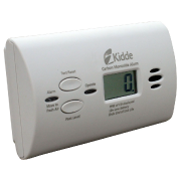- 773 741 1359
-
This email address is being protected from spambots. You need JavaScript enabled to view it.
Fire Safety Learning Center
Understanding Carbon Monoxide Poisoning

What is carbon monoxide poisoning?
Carbon monoxide (CO) is a gas commonly found in combustion fumes. Such fumes are created by burning gas, wood, propane, or charcoal. Not surprisingly, carbon monoxide poisoning is caused by breathing in too much carbon monoxide. Inhaling the fumes allows it to build up in your bloodstream, and it replaces the oxygen that your red blood cells need with harmful carbon monoxide molecules. Prolonged exposure to this odorless, colorless, and tasteless gas can lead to severe damage to one’s tissue and brain, and it can even lead to death.
Carbon monoxide symptoms & signs
Due to its nature, you cannot see, smell, or taste carbon monoxide. These qualities have caused it to be known as a “silent killer.” There are, however, a few ways to detect if you may have been poisoned by carbon monoxide.
Early on, carbon monoxide poisoning causes the infected person to have flu-like symptoms. This includes fatigue, headaches of varying severity, and nausea. Other symptoms include dizziness, weakness, disorientation and confusion.
Common sources of carbon monoxide
There are many household appliances and other everyday items that can produce carbon monoxide. The fuels that these devices use to operate release carbon monoxide, and if these fumes are not properly ventilated, you can have problems. Some common sources of carbon monoxide that you should be aware of are:
- Gas powered appliances, such as water heaters, stoves, and generators.
- Blocked/closed off chimneys.
- Motor vehicle engines, such as engines in cars and boats. If you swim near or underneath a running boat, you risk exposure to carbon monoxide. A running car in an enclosed garage is a situation likely to cause carbon monoxide buildup and potential poisoning.
- Propane grills, heaters and stoves. (Grills being operated in an enclosed area can lead to trouble.)
- Kerosene space heaters.
- Spray paint, degreasers, solvents, and paint removers.
- Wildfire smoke.
- Cigarette smoke.
How to avoid carbon monoxide poisoning
One of your primary defenses against carbon monoxide poisoning is the use of carbon monoxide detectors. These devices are inexpensive and can smell what your nose cannot. CO detectors should be installed in any room or enclosed area where fuels are being burned. Illinois statute also require every dwelling unit to be equipped with at least one approved CO detector within 15 feet of every room used for sleeping purposes.
You can also reduce the risk of carbon monoxide poisoning by practicing some preventative measures.
- Test your carbon monoxide alarms and replace batteries regularly.
- Have your vents, chimney, flue, and heating systems inspected yearly by a professional.
- Operate all gas and wood burning appliances according to the manufacturer’s instructions.
- Never operate cars, motors, or any gas/coal/wood burning appliances in non-ventilated spaces such as an enclosed garage. For example, don’t start your car with the garage door unopened. A dangerous carbon monoxide build up can occur quickly!
- In the case of a fire, get low to the ground to avoid inhaling the smoke while escaping the area.
- Recognize the signs. Use the list of symptoms above to spot the signs of carbon monoxide poisoning.
If you believe that you or someone else is displaying the symptoms of carbon monoxide poisoning, get out of the building that you believe has CO present, and get fresh air. Contact 911 and get to your nearest hospital. The American Association of Poison Control Centers is available 24 hours per day by calling (800) 222-1222.
If your carbon monoxide alarm goes off, but no one experiences any CO poisoning symptoms, play it safe. It is still imperative that you vacate the space and call the fire department to have your home inspected by a qualified technician.
Carbon monoxide detectors in common areas and commercial spaces
If you own a condominium or commercial space in Chicago it is important to understand that these units (along with fire extinguishers and other fire safety equipment) are required throughout the building. Our technicians can evaluate your property and ensure that it is protected and legally compliant. Contact our team at Connected Fire Safety Services to learn more.

